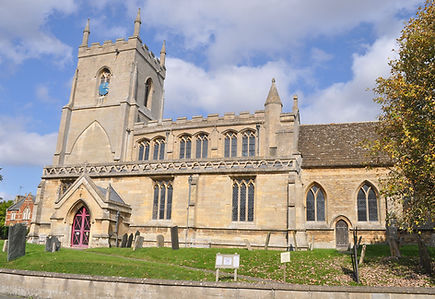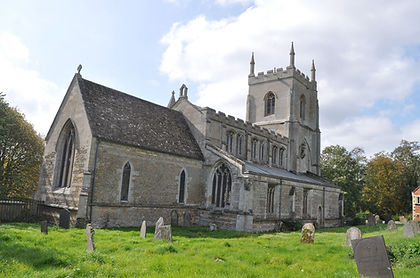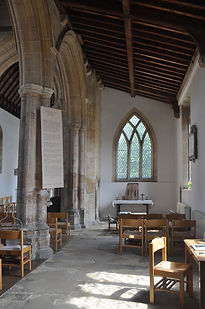ASLACKBY : CHURCH OF ST JAMES
Church Post Code NG34 0HZ
Open to visitors
Visited August 2025
I sit here typing this in the late autumn of 2025, some 20 years after I visited my first church. In all that time, after visiting getting on for 2000 churches; one of the things that I have the most trouble getting my head around is how the locals pronounce Aslackby!
I stayed a few times in digs at Hanthorpe a little north of Bourne. On the first night of my first stay there the proprietor asked where I had visited that day; ‘Aslackby’ I replied emphasising the ‘C’ and the ‘K’ ‘do you mean Aselby’ he replied emphasising the lack of the ‘C’ and the ‘K’! Well, bowing to local knowledge Aselby it is but goodness knows how!
Aslackby is a small pleasant village which can be found alongside the busy A15, part way between Bourne and Sleaford. Bourne itself is some seven miles off to the south with Sempringham across the flat Lincolnshire farmland to the north east. It boasted a population of 257 at the time of the census of 2021.
The church of St James stands on raised ground in picturesque surrounding to the east of the village, not too far away from the A15 but it is quiet and peaceful here; a lovely scene with red telephone box close by dating to 1935 and having its own Grade II Listing.
The church here has always been special to me; a pleasant place to sit and rest for a while, to take on water after a day out on the cycle when heading back towards my digs. A friendly and welcoming church; always open to visitors, which won a prestigious award in 2024, winning Church of the Year at the National Church Awards; being a shining example of a sustainable church which is relevant to the community, well looked after a open to all.


The village here has associations with the Knights Templars, a medieval Catholic military order which was formed around 1199; set up to protect Christians visiting the Holy Lands. They became a powerful organisation before they were disbanded in 1312. The Templars had several sites in Lincolnshire, with the site here at Aslackby being built along the same lines as the one of Temple Bruer, to the north of Sleaford which is also covered by this site. Built around 1162 it consisted of a chancel with rounded apse at the east, a rounded nave at the west end twin towers which were added around 1200. After the disbandment of the Templars the complex here was given to the Knights Hospitallers with the last surviving part of the structure, one of the towers, collapsing in 1892.
Arriving here for a revisit on a sunny afternoon towards the end of the long hot, dry summer of 2025; this was the penultimate church of what had been a ten church crawl, all of which were in Lincolnshire with nine being open with the tenth open through a kind key holder.
The village was mentioned in the Domesday Survey of 1086, with no church or priest being recorded. The church that we see today dates from around 1300. The church that we see today consists of west tower, nave with north and south aisles and clerestories, south porch and chancel.
The church dates back to the early 14th century with rebuilding during the 15th century. There was a period of restoration in the mid 19th century, at which point the chancel was rebuilt with a further period of restoration in the 1890’s. In more recent times the west end of the church was reordered between 2008 and 2010 and the tower, north aisle and nave roofs were completely re-leaded with the south aisle roof repaired in the 2020’s with funding coming from the National Lottery Heritage Fund.
Looking at the church from the south, this is a lovely structure. The early 14th century west tower is heavily buttressed, battlemented and pinnacled with church clock in the traditional colours of blue and gold faces out from the south face. The church is perpendicular from the west with 14th century pointed west doorway.
Curiously, there are very large blind arches to north south and west, with the arch to the west being punched through by a fine three light late 15th century window. I can’t recall ever having seen anything like these before and I wonder if plans had been made for a grander tower, which had to be altered.
A single gargoyle can be seen on each side of the tower, offset from the centre, whilst grotesques of fantastic beasts with impressive ears look out from the buttresses.



The clerestory is in the form of six two light windows, curiously arranged in pairs, with a diamond frieze above. A carved parapet running the length of the nave is described as being Islamic in nature; which considering the connection that this church had to the Holy Lands through the Knights Templars is logical.
At the south east end of the nave there is an octagonal stair turret which leads out on to the roof. At the east end of the nave is a small bellcote from which the Sanctus bell would have been run in pre reformation masses. Mostly, these bells were hand held but sometimes a small external bellcote was erected and this is the case here.
A finely carved scratch dial can be seen at the east end of the south porch; the chancel which was rebuilt in 1856 has a steeply pitched tile roof. Benches are set out to the south and west of the church; a pleasant place to sit for a while and watch the world go by, not that much is liable to go past
There are three bells in the ring here with the first two of the ring cast by different generations of the Norris family from their foundry at Stamford. The first of the ring is inscribed ‘OMNIA FIANT AD GLORIAM DEI’ which translates as ‘Let all things be done for the glory of God’); this being cast in 1633 by Thomas Norris. This also has on it the names T Groves and R Mayfield who were the church wardens of the day.
The second was cast in 1683 by Tobias Norris III and has the names John Quinsey and Isay Charls; again the wardens here when the bell was cast. The third has little in the way of text that can be read. Thomas North in his study of the church bells in Lincolnshire, which was published in 1882 notes that the word ‘DEO’ is discernible along with stamps used by Bellfounder Thomas Newcombe who worked out of Leicester, with a suggested date of 1580.
North also notes a Priests bell, cracked and unhung, with the same ‘OMNIA FIANT…’ inscription. This one is dated 1611 and this has the Norris stamp and therefore would have been cast by Tobias Norris I who had founded the Stamford bellfoundry.



Entering the church through the south porch, my attention was taken by some graffiti. It is always interesting to think that people have recorded what they have seen by carving it in to stone. Here we see herds of deer and flocks of birds; with my mind turning to graffiti at Pickworth a few miles away where someone had carved a body hanging from a gallows; a similar but not as pleasant memory to record.
There is ship graffiti which is mainly found in coastal churches but is also found inland. The thought is that this is an outward manifestation of a prayer for a safe voyage or for the souls of those lost at sea. So where does that fit in here, a good few miles from the coast. No idea to be fair except to note that John Dods, an Aslackby labourer sailed to the New World on John Smith's expedition in 1606. Is it stretching things too far to think that this might be a prayer for safe journey prior to him setting sail?
We also see a fish, what looks to be a processional cross and the outline of a boot. There are plenty of initials with dates as well. EB was here in 1765 with Micah Mellor making his mark in 1777. For me though, the most interesting is where you can tie up an initial with an important date. IE carved his or her mark in 1815; the year of the Battle of Waterloo. Who was this person, what was going on around him as this was carved. What did this person know of the fight against Napoleon? Memories turned to Imogen who signed her Christian name in chalk at Temple Bruer in 2020, a more recent memorable year, for all the wrong reasons.
Interestingly, one of the most interesting carvings here is the name Spence Broughton who was a highwayman who was executed in April 1792, with his body being placed in a gibbet at Attercliffe Common where it was to remain hanging for the next 36 years!








The name Spence Broughton can just be seen at the top of the photograph above left.
Moving inside, it was bright and welcoming, with the lack of stained glass helping in that respect. There are three bay arcades to north and south, each dating from the 14th century, which have clustered piers with moulded capitals.
Looking towards the east, the chancel arch itself is a rebuild from the time that the chancel was rebuilt. A close look high up to the south of the chancel arch shows a bricked up doorway which would have led out on to the rood loft; which would have held the rood itself, carving of the crucifixion which would have depicted Christ crucified with Mary the Mother of Jesus and John alongside the cross. These were an integral part of pre reformation churches but were seen by the reformers as idolatrous and were taken down and destroyed accordingly.
Looking towards the west, the tall slim 14th century tower arch stretches virtually up to the roof. Interestingly there are see through cut outs of five human shapes sat in the nave; these in remembrance of specific people who have passed on.





Moving in to the rebuilt chancel the rebuilding of the mid 1850’s appears to have taken away the ancient history here, with no sedilia, the seating for the priests during the Mass and the piscina in which the holy vessels used in the Mass would be washed. These would normally have been found against the south wall of the chancel.
The east window is of three lights and for the most part clear glass; there being just three small emblems; we have from left to right a red Maltese cross symbolising the Knight Templars, three scallop shells which is the symbol associated with St James and a white Maltese cross on black background which is the symbol for the Knights Hospitallers.
The high altar has scallop shells alongside the cross and a nice touch is that the kneelers propped up against the altar rails replicate the stained glass symbols, with the Knights Templar cross, scallop shells and the Knights Hospitallers cross.
The east ends of north and south aisles retain their history; each has an altar set up and each retains its 14th century piscina. The piscina in the south aisle can be seen under a beautiful ogee arch and contained when I visited two teddy bears, one dressed in clerical robes with ‘dog collar’. The south aisle also has the doorway which contained the stairs leading up to the rood loft.








It was good to be back here again after a few years; in Gary’s car this time rather than on the cycle; week long cycling trips now being a thing of the past as time takes its toll! The church here is open and welcoming and is well worth a visit if you are in the area. The interested churchcrawler will find plenty of open churches in this area. Neighbouring Kirkby Underwood is not one of them but it was to there we headed; the final church of the day, more in hope than expectation and was surprised to find it open, albeit only as someone was working up in the tower.
This is a fine church, both in terms of architecture and for what it stands for; a church with a good heart doing its Christian witness quietly and without fuss. A church to be treasured.